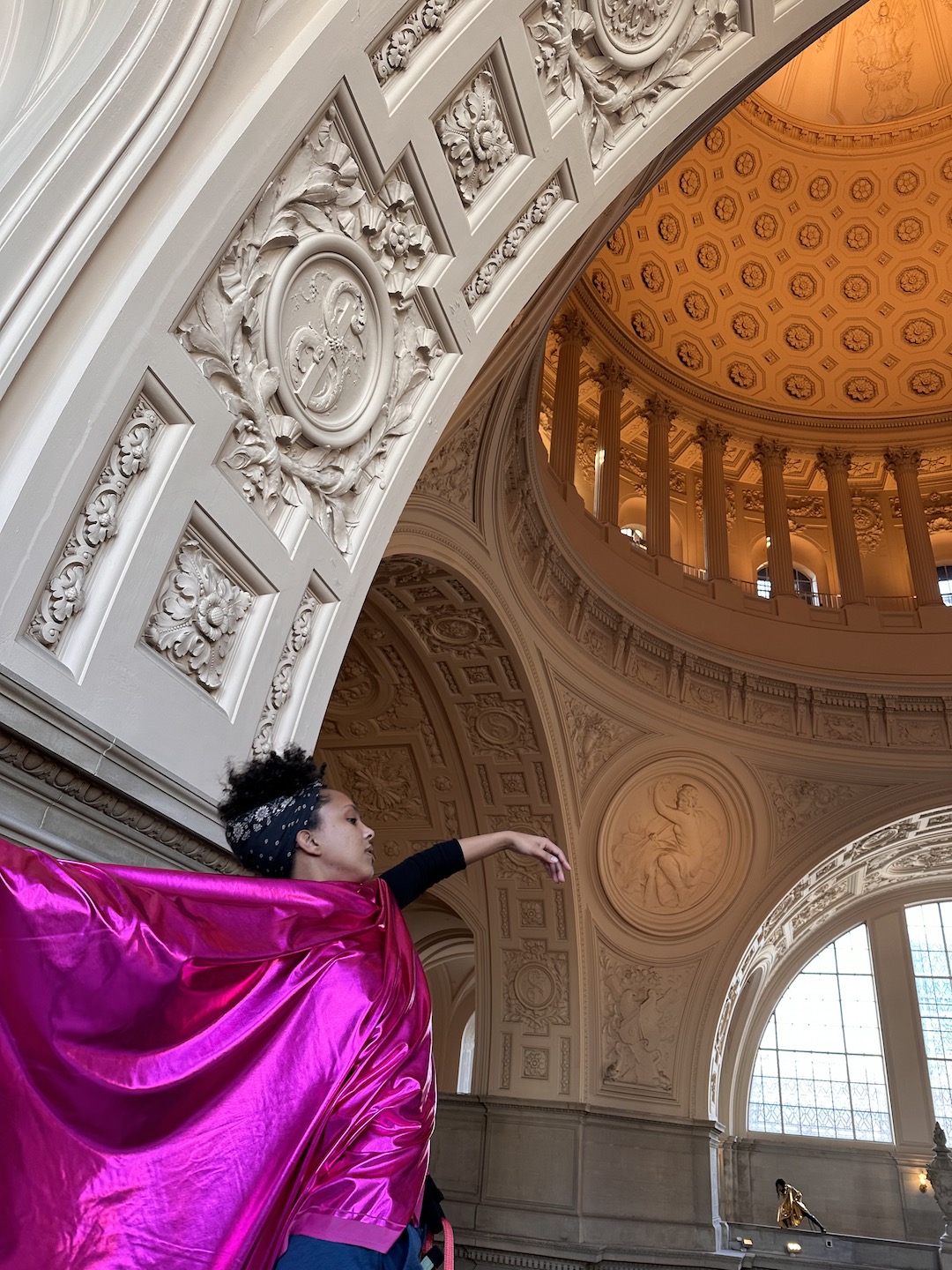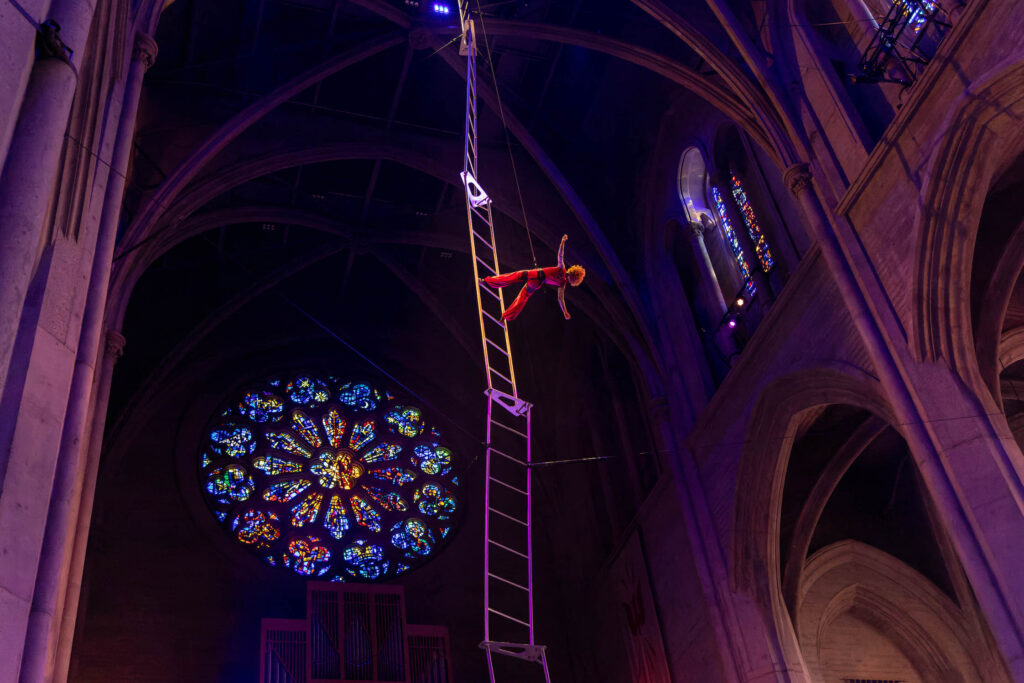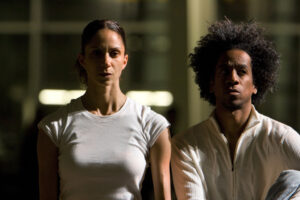
Photo by Wayne Hazzard
[ID: Saharla Vetsch, a caramel-colored Black woman draped in shiny fuchsia fabric, gestures gracefully amidst the neoclassical architecture of San Francisco City Hall. We see her in profile and only her head and left arm are visible outside the fabric. A navy blue and white bandana is tied upwards around her afro.]
Joanna Haigood’s The People’s Palace premieres at San Francisco City Hall May 9, 10 and 12. I had the pleasure and honor of watching a rehearsal and later interviewing Joanna (all over Zoom). Rooted in the knowledge that neoclassical architecture, both implicitly and explicitly, reinforces the invisibility of marginalized populations, The People’s Palace is both intervention and celebration meant to lift every voice. Joanna shared with me this deeply germane quote by adrienne maree brown: “…we have to understand that imagination shapes the world and so those of us who have been oppressed by how others imagine the world, the supremacists, the patriarchs, the war mongers, the capitalists, we have to imagine something so compelling it moves us beyond and out of the compliance with our entrapment in these systems that do not love us.”
Let us radically imagine our worlds.

[ID: Saharla Vetsch, a caramel-colored Black woman in an orange jumpsuit, hangs suspended in midair, attached to rigging from the ceiling of San Francisco’s Grace Cathedral. Her body faces upwards, arms outstretched, with her feet touching a long hanging ladder. A large, ornate stained glass window is in the background.]
This interview has been edited for length and clarity.
Maurya Kerr: I’ll just share some of my impressions from rehearsal if that’s cool as a starting point. I was really struck by so many of the artists saying they felt beautifully small and held. I was thinking about that return to embrace and how rarely we get that in our lives. I’d written down in my notes something about the safety of the fetal-ness, being held that way, womb-like. Also this sense of being sideways and aslant in the world, off-kilter, that the aerial work allows you to do, and how that relates to the double consciousness Du Bois talked about, seeing the world as if everything is slightly askew compared to people who aren’t marginalized, either racially or through class. I’m wondering if that figures in for you—or what does aerial offer you?
Joanna Haigood: I guess for me, it’s many different points of perspective, being able to see the world from all these different angles. Oftentimes, we feel like we know where we are, but as soon as we change our relationship to up and down, it’s very different. And the things that are revealed are sometimes, well, life-changing in the biggest respect, and illuminating in terms of where we are, who we are to each other, what we are to our environment. It’s a sense of scale, really. If you’ve ever been down to the desert, like Death Valley, or amongst the giant sequoias, those feelings are immediately apparent or bubble up.
MK: It’s also feeling small in safety, as opposed to feeling small and diminished. I feel like we’re always having to be big in the world to survive, and when we feel small, it’s often at our expense. So that ability to be cradled felt unique and special.
JH: Yeah, because in this context, feeling small is really about being able to feel and acknowledge the larger scale of the world. Not that we are insignificant, but that there is so much happening alongside you.
MK: That sense of scale, it’s a different virtuosity and a holding space. I know that having been in your work and seen your work, it is so much about the holding of space and presence, as opposed to choreography or physical pyrotechnics. I think that’s one of the great beauties of your work, plus this sense of working to place, or of place, or from place. So I was wondering about how you, within this process, how you’re directing the artists, for example, in the section about liberty.
JH: For me, it is much more about mining, exploring, connecting, and sharing each other’s life experiences, things that people have gone through that relate to these particular virtues [Henri Crenier’s four Civic Virtues: Learning, Liberty, Strength, and Equality], or how they relate to them in general from where they stand. And also, what are the expectations of these ideas and ideals. The whole piece, for me, is about upending the notions that the architecture proposes: white supremacy, patriarchy, and capitalism.
MK: It’s an incredibly white space on every level.
JH: Yes, very white. When we talk about liberty from a European perspective, it’s based on politics, class, and religion. But from our perspective, as people of color, it’s all of these things plus these really horrific notions of race and caste, as Isabel Wilkerson would say. Liberty is linked to our struggle for humanity, a struggle we’ve been in for many generations.
MK: With that, the sense that not much has changed. I think you’re saying that as well.
JH: It’s changed… some things have changed on the surface.
MK: But the essence of how we deal with Blackness or class…
JH: And how we see and respond to each other, where our priorities are, it’s still very imbalanced. The whole thing of learning: I’m working with Indigenous culture bearers Gregg Castro and Jonathan Cordero, who are helping me navigate through the idea of decolonization and come to some deeper understanding of our histories. One of the virtues is learning, and thinking about what that is from an Indigenous point of view. So much of their teaching and from where they build their social structure and relationship to life in general is anchored in this notion of harmony with nature. And that is precisely the area where we have gone so astray. Like, we’re really far off! We’re always trying to control and harness nature. That idea of being the superior being on the planet has interrupted this relationship that, when it works from the point of view of integration and harmony, feeds and creates this environment where we really thrive.
MK: I think thrive in ways that we can’t even comprehend. And it does seem, too, that City Hall is the antithesis.
JH: Completely!
MK: That kind of edifice, that kind of architecture, the literal and figurative whiteness is the antithesis of harmony with nature.
JH: Yeah, and there are no direct references there to our connection to nature, and no references to Indigenous people, in terms of the statuary or anywhere.
MK: It’s important to go into a room and ask who’s missing. And it’s usually Black people; it’s almost always Indigenous people. I’m never in spaces with Indigenous people. Society doesn’t ask that enough—who’s missing from this work space, this dance space, etc.
More on aerial-ness—the balance of support and surrender feels important and in line with Indigenous culture. I was also thinking about the folktales that slaves could fly, which I know is very present in your mind and work. Those are some things I was thinking of as I was taking notes and watching, some of those ideas and motifs that feel integral, I was going to say a Black experience, but I think it’s more an integrated experience, speaking with some of the language you’ve been using around indigeneity.
JH: I’m impressed you could see that through Zoom. Like, that was really good watching! [both laugh]
MK: I taught over Zoom for three years, so I’m zeroed in!
I love the title The People’s Palace. Obviously that’s a reclamation—we don’t think of ‘palace’ and ‘people,’ so the combination of those words is important.
JH: Yeah. This is what it was called when it was built.
MK: Oh really! I didn’t know that.
JH: That’s what the mayor [James “Sunny Jim” Rolph] called it. That was his desire, to create a place where people felt like they were being honored and had a place to feel celebrated.
MK: Majestic and grand, that “the people” are allowed to feel that, have that invitation.
JH: At the end of the day, it ends up that “the people” are very specific and not inclusive. But when I was at City Hall with an architectural historian, he mentioned that for him, the diversity of people in the building dispels the ideologies of whiteness and patriarchy. I don’t know if you’ve been there on a busy day, but there are like twenty weddings happening all at the same time [laughs], quinceañera celebrations, just so much activity. Really, every possible type of human is there doing something deeply meaningful to them. It feels like their place, their right, and I love that about the building.
MK: That’s awesome. I didn’t know that. So it sounds like the intentions of the building are happening!
JH: Yes. But I also feel that the architecture, what was chosen and what it represents on the physical plane, is the antithesis of that. This project is focused on the intentions of neoclassical design in civic architecture. I think those intentions are very clear, even in the choices of the added statuary on display around the building. People might say, ‘Oh, it’s a reflection of the time,’ but that’s also what they say about the people who enslaved others, right?
MK: Yes, ‘that was just what happened.’
JH: And it wasn’t like Asian people weren’t here; they were here. There were Black people here, all kinds of people here. They weren’t the majority, but they were here.
MK: There was enough representation to be included.
JH: That’s just the thing, I mean, even in the Exposition [1915 Panama-Pacific International Exposition], there was a Primitive Pavilion, where visitors got to look at these ‘underdeveloped Native cultures,’ while around the corner were gorgeous examples of the Beaux Arts and European architecture and culture movement; we can see which was considered to be more aesthetically beautiful and intellectually superior. But we, of course, know that to not be true.
MK: Yeah, it’s always the vaulting of European intelligence. It is interesting though for a building to fulfill its intended intention, yet be modeled after whiteness. I mean, it fulfills its intentions for “the people,” but “the people” aren’t represented within the architecture.
JH: Well, again, it’s true that at that point, white people—well, it’s still true—were the dominant voice and everything else was considered lesser. [Thomas] Jefferson was really influential in this movement, particularly with the Beaux Arts and these classical styles as representing these civic ideals, and at the same time enslaving people.
MK: So we’re talking about architecture and working against those symbols into more inclusivity. Is there anything beyond what’s on your website that feels critical to talk about with The People’s Palace?
JH: Well, there’s been a lot of discussion around dismantling many things—dismantling white supremacy, colonization, statues—and I’m not really calling for this building to be torn down. I’m more interested in being in conversation about what these things mean, what these built environments are there to support, and then how we can rethink or create interventions that bridge these worlds. And I’ll be curious about what conversations come up, how we can move forward in a way that creates environments where all people feel like they belong.
MK: What’s your utopian result of people seeing this performance? Or what kind of conversations would lead to praxis as opposed to just another conversation about an art piece?
JH: Well, I think it would be really great for a group of architects and artists to get together and explore what are the things that we can honor about this architecture and what are the things that we can introduce to bridge this really gaping hole.
MK: Okay—we’ll put the word out! That would be amazing! [both laugh]
JH: There are some conversations about architecture and whiteness getting some traction right now because it’s all operating on such a subliminal level at this point. People are not walking around in their environments aware of the lineage of whiteness.
MK: Well, I think that particularly for white people, whiteness is invisible, and so when you go into these sort of vaulted spaces, white people generally aren’t asking that question of who’s missing, or ‘how is my whiteness loud in this space and time,’ as opposed to just assuming it as the norm. Whiteness is not invisible at all to people who are not white.
JH: We’re constantly navigating that relationship. I was trying to explain to someone that for us, we’ve been thinking about this since the moment we were conscious, and about how I work through these varying identities—that when I wake up and am going out, first I prepare Joanna, and then I prepare myself as a Black person.

[ID: Two Black people—Maurya Kerr, a light-skinned woman and Robert Henry Johnson, a darker-skinned man—sit closely together facing toward the camera looking slightly to the left; she down, he up. Both are wearing white tops. Her brown hair is pulled back and she looks lost in thought. He has a black mid-length afro and looks wary.]
MK: I wanted to talk briefly about Robert Henry Johnson.
JH: Yeah. [sadly]
MK: I was looking at your website and it was wild to see photos of me and Robert from Departure and Arrival [2007]. He was such an integral part of your process from the very beginning. I feel like he was such a masterful carrier of narrative in his body, of storytelling. So I don’t know if I want to ask what it’s like not having Robert Henry in your processes right now, just wanting to bring that huge absence into our space.
JH: Yeah, it’s a very deep, heavy, sad loss. He was supposed to be in this piece—I’m dedicating it to him. He was such a deep wanderer and so incredibly gifted.
MK: Oh my God, so gifted. Like his ability to shapeshift…
JH: Yes, shapeshifting.
MK: … was so remarkable and it looked like he did it with such ease, but I also know the appearance of ease takes a toll.
JH: He worked deeply on his craft, he really did. He worked a lot of things out, studied a lot. He was one of the few people I would only have to say a few words to and he knew exactly what I was after, almost like there was a kind of telepathic connection.
MK: I think part of the deep wandering of him was also that his instincts were so attuned from the vastness of how he inhabited the world.
JH: I really miss him a lot. I’m thinking about certain parts of this piece and about him, the conversations we would be having right now, both verbally and non-verbally.
MK: And also as someone who’s probably been in your work the longest, the loss of that legacy of communication and collaboration, I imagine it’s quite large for you.
JH: Yeah.
MK: So lovely to connect; thank you Joanna.
JH: So when do I get to interview you?! [both laugh]
This article appeared in the Spring 2024 issue of In Dance.


